Saving tomato, pepper and other veggie seeds is easy and satisfying—especially when the vegetables come from your own garden. There are a few reasons why you should save your seeds to replant next year. It gives gardeners a sense of achievement by completing the growing cycle. In addition, you’ll always know your produce’s quality and history firsthand. Follow these simple steps to save, store and replant seeds.
How to Start Saving Seeds

Start saving seeds by picking out the best ones. Some seeds must come from fresh, mature fruit, says Brian Sebade, a University of Wyoming extension educator. Winter and summer squash, peppers, tomatoes, cucumber and tomatillos are all best when their seeds are harvested from vine-ripened and mature produce. But seeds from peas and beans are best picked after they’ve dried on the plants. The process hardens the seeds and makes them better suited for growing.
Learn how and when to start seeds indoors.
Wash Seeds Carefully
Remove seeds from each piece of produce and strip away excess flesh. Place seeds in a colander and wash with cold water. Be gentle and don’t scratch them. Scatter seeds on a paper towel or newspaper, then let them dry on a counter.
Check out the 10 seed catalogs every gardener needs.
Store Seeds Wisely
Once dry, store the seeds in a paper envelope and keep them somewhere cool, dark and dry until planting season. Be sure to label seed packets to avoid confusion later.
Save time next spring by direct sowing seeds in your garden.
Test Seeds Out
A few weeks before you want to plant the seeds, take a dozen or so out of storage, wrap them in a wet paper towel and keep them in a plastic bag in a warm spot. Brian suggests unwrapping them after a week or two. The number of seeds that germinate will tell you how many of your seeds will likely sprout in the ground. If none grow, you may have a bad batch.
Psst—you can also save seeds from blooms! Check out the top 10 flowers for harvesting seeds.
Seeds You Should Not Save: Biennials and Hybrids
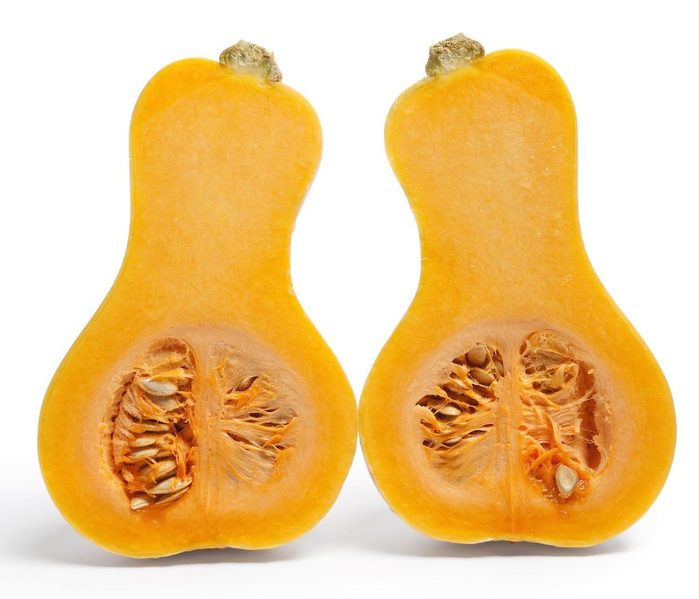
While you certainly can collect seeds from carrots and beets, Brian cautions against doing so. This is because both beets and carrots take two years to produce seeds, which means you need to leave the vegetables in the ground, taking up valuable garden space, for an extra year between plantings. (For these crops, check out the best places to buy plants and seeds online). Plants such as squash and peppers can hybridize if planted too close to different varieties. Experts recommend against planting more than one type of squash or pepper in a garden if you plan to harvest the seeds to grow the same variety next year.
Learn how to make newspaper pots for starting seeds.
Saving Tomato Seeds

If you’re new to saving seeds, tomatoes are a good plant to start with. Here’s the step-by-step instructions for saving tomato seeds:
- Start by selecting a ripe tomato that’s not diseased or damaged.
- Squeeze cut tomato halves over a glass or jar.
- Add a small amount of water and let sit for a couple of days.
- Remove the viable seeds that sank to the bottom, then rinse seeds in strainer with cold water.
- Let the seeds dry before storing. Keep seeds in the refrigerator if desired.
Next, check out 9 butterfly flowers that are easy to grow from seed.
Do Your Homework and Come Prepared
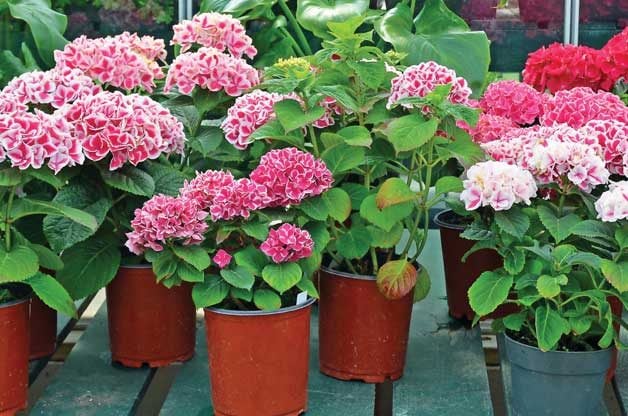
Before you head out the door, do your homework. Jennifer Youngquest, director of marketing for English Gardens in West Bloomfield, Michigan, suggests signing up for store newsletters. “Many garden centers send newsletters via snail mail or email that are filled with ideas, new products and promotions,” she says.
Simply by joining a store’s garden club or e-newsletter list, you’re privy to special deals and insider information. If you already receive the newsletter, pay closer attention to it. Some offer incentives like coupons for $10 off a $50 purchase. It’s also a good way to find out more about the store, its layout and its policies.
Before you go, make a detailed list and stick to it. Garden centers bank on impulse buys—seeing all those beautiful flowers prettily packaged after a long winter is like grocery shopping on an empty stomach. But if you stick to your list, you’ll be more likely to come home with exactly what you need.
If you have a lot of questions or need some personal shopping help, Jennifer suggests calling ahead to make an appointment with a sales associate. “Many customers are able to get free gardening advice and one-on-one attention that way,” she says.
To be extra prepared, make sure you’re not making these new gardener mistakes. And, here’s what you need to know before you buy indoor plants online.
Use Technology to Save Money
Social media, gardening apps and online tools have made shopping simple. Lisa Pasquesi of Pasquesi Home & Gardens in the Chicago area suggests doing some online research before you shop. “Many garden centers provide a plant finder on their websites so that customers can search the database, narrow down their choices and ultimately save time at the garden center. With just a few clicks of the mouse, you can customize your shopping experience with the right plants for the right places in your yard.”
Using social media to your advantage is also a smart move. “Every month at Pasquesi, we feature something different on sale,” says Lisa. “The most timely way to get the word out is via social media.
“We also run certain coupons or contests for one outlet versus another, so it’s important to subscribe to all areas. A few months back, we had a $500 gift card giveaway on Facebook, and on email, we gave out a coupon for those that joined our email club. These are simple ways to get great deals for free!”
Check out 10 seed catalogs every gardener needs.
Choose the Right Plants for Your Landscape

Finally, it’s time to head to the garden center. But with so many eye-catching new plants vying for a place in your garden, it’s important to make good choices.
Though it may sound obvious, the pros say that not everyone reads the tags before buying. Stores put out pots of gorgeous plants in prominent places, but before you add them to your cart, make certain they fit your growing conditions and available space when mature. When buying trees and shrubs, choose those on the smaller side. You’ll enjoy watching them grow, they’re easier to transport and plant—and they’re cheaper.
Pay attention to quantities. Certain items, like compost, soil and grass seed, make sense to buy in bulk rather than in bags. (You might be able to get ripped bags at a discount if you ask.) Same goes for flats of plants that you know you and your friends or neighbors can share. Buying in larger quantities usually saves you money. You might even negotiate a discount if you buy a lot of a particular plant or item.
When it comes to certain plants, it’s a good idea to buy in small quantities and to get only what you need. If you only want a few tomatoes, just buy a few tomatoes. When buying perennials, pick up a small pot instead of a gallon. They cost half as much and will usually take just a season to catch up in your garden. By next spring they’ll be happy, healthy and well established. Also, many potted perennials, such as hostas, can be divided right away when you buy them. That could give you as many as four plants for the price of one.
Get to Know the Staff

Never underestimate the importance of being nice to the staff. Apart from the benefits of talking to someone with shared interests, you’ll learn when to get deals. Ask questions of the staff, tell them about your garden, and they might let you in on a few local secrets—not to mention that it’s nice to see friendly faces when you shop.
While you’re chatting, ask a staff member about the store’s delivery times. Inquire when new products come in and when plants are due to arrive, Jennifer says. “Most stores are on a schedule of shipments, and you’ll get first choice. Often they will even call you when they arrive, if you ask,” she adds.
Going to the garden center should be a fun, relaxing and enjoyable experience. And if you do your homework and come prepared, you’ll save money, too!
Check out 25 secret garden tips we learned from grandma.
More Garden Center Shopping Tips
- Dress comfortably and wear sensible shoes.
- Shop during the off hours, such as weekday evenings.
- Use the staff to your advantage. Ask questions—they are there to help.
- Check the clearance section for perennials that have finished flowering. With a little TLC, they’ll be great next year for a fraction of the cost.
- Visit often. You’ll notice patterns in sales and shipments, and clearance markdowns.
- Check the label before you buy. The flowers might be gorgeous, but make sure you have the right spot to plant them at home.
- Did you know many plant nurseries post coupons via email or social media? Get on the e-list and you won’t miss out!
Next check out the best websites for buying flower bulbs online.
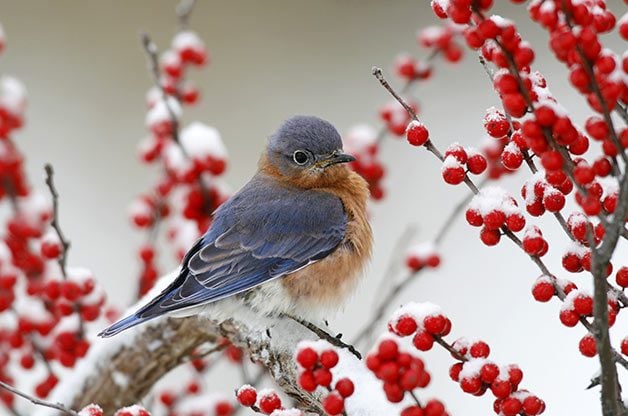
Exotic invasive shrubs pose a threat to natural areas. The qualities that make them attractive and low maintenance also allow them to survive and spread when they jump the garden fence into the woods and fields. Once there, they outcompete native plants that are vital to the survival of wildlife.
Removing any invasive shrubs already in your yard can be easier said than done. Some are still commonly sold at garden centers and have design value in the landscape. And some even offer food for birds or butterflies, so it might seem counterintuitive to eliminate them. Remember, though, that even if some wildlife benefit from these shrubs, they can destroy habitat for many other species. In the big picture, native plants provide the best wildlife habitat.
Luckily, there are great native alternatives to invasive shrubs that can play the same role in the landscape.
Psst—check out the worst invasive plants for your yard. And here’s how to remove invasive plant species for good!
Invasive Shrubs: Butterfly Bush

Renowned for its ability to attract butterflies, butterfly bush has become invasive in the Pacific Northwest and much of the East. If you want to grow this plant, look for sterile, seedless cultivars like Blue Chip.
Butterfly Bush Alternatives
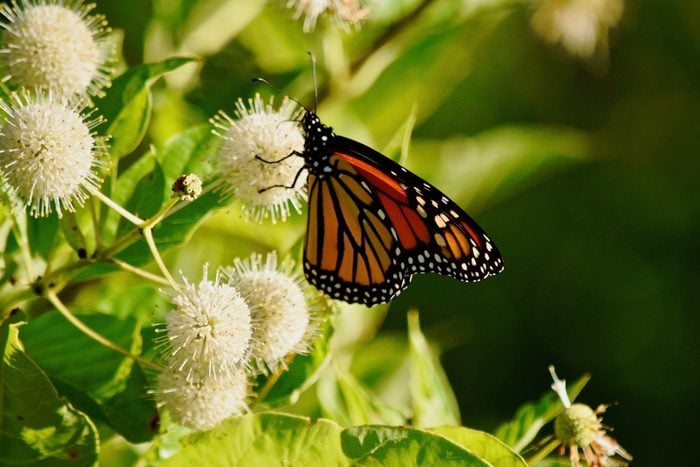
Buttonbush, New Jersey tea, summersweet and elderberry are excellent shrub alternatives for the East; all are irresistible to butterflies. Elderberry works in the West, too, along with western spirea, California lilac, blackbrush and other ceanothus species. And unlike butterfly bush, which doesn’t support caterpillars, many of these shrubs are also caterpillar host plants.
Is an Amur maple shrub invasive? Here’s what you should know.
Invasive Shrubs: Burning Bush

This ubiquitous shrub is popular for its deep red fall foliage, but it’s a woodland invasive in the East, Midwest and South.
Burning Bush Alternatives

Native shrubs that provide an equally stunning scarlet display include sweetspire, blueberry, and fothergilla. These vibrant alternatives also offer nectar to pollinators, berries for birds or even both.
Check out the top 10 summer flowering shrubs for full sun.
Invasive Shrubs: Japanese Barberry and Pyracantha

These invasive shrubs feature bright red or orange berries. Birds eat them and spread the seeds beyond the garden, where they germinate and dominate. Barberry is invasive in the Northeast, the Great Lakes area and parts of the Northwest, while pyracantha is a problem in California, Texas and parts of the Deep South.
Barberry and Pyracantha Alternatives
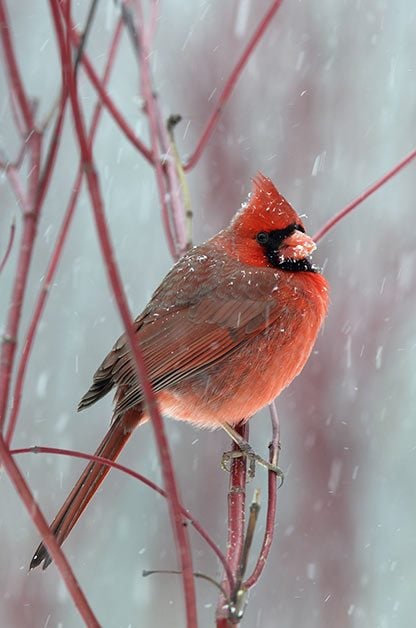
Many native berry-producing shrubs are better choices, including dogwoods, winterberry holly, elderberry, chokeberry, native viburnums, blueberry, bayberry, wax myrtle, Oregon grape and manzanita. Spicebush has red berries and is also unpalatable to deer, just like these two invasives.
Grow native ornamental grasses for birds and butterflies.
Other Invasive Shrubs to Avoid

You might have invasive shrubs on your property that aren’t sold in nurseries and that you didn’t deliberately plant. With these long-established invasives, it’s important to put something in their place after removal so that the invasive plant doesn’t come right back. Multiflora rose, Russian or autumn olive, Himalayan blackberry, buckthorn, and privet or bush honeysuckle should all be removed and replaced.
Native Shrub Alternatives

Witch hazel, Carolina rose, highbush blueberry, and hawthorn are all good alternatives. Try any combination of native plants that suits the landscape and offers benefits for wildlife.
Next, check out 15 trees you should never grow in your yard.
If you spend any time near gardens or vegetable and fruit crops, you’ve probably laid eyes on a few brown marmorated stink bugs. Some people refer to these as shield bugs, but either moniker identifies the same pest. (The scientific name for the stink bugs is halyomorpha halys, in case you were wondering.)
More concerning than their name, though, is their game. These not-so-innocent looking insects have one goal in life — to take control of just about any crop they can get their tiny little legs on. This includes everything from commercial tomato crops to the peppers and green beans you carefully cultivated in your backyard.
Here’s how to get rid of grasshoppers in your yard.
What Are Shield Bugs and Where Do They Come From?
Shield/stink bugs are an invasive species that arrived in the U.S. in the 1990s from Asia via Allentown, Pennsylvania, says David Price, a certified entomologist and technical director for Mosquito Joe, a nationwide pest control company. According to the Environmental Protection Agency (EPA), they likely hitched a ride in a shipping container. From there, the pests spread rapidly around the nation.
Now, shield bugs are almost everywhere — in 47 states to be exact. They are the biggest nuisance in Oregon, Michigan, Tennessee and the mid-Atlantic region, where they are often found chowing down on agricultural crops. Favorites include apples, pears, grapes, peppers, tomatoes, hazelnuts and corn.
“They actually attack agricultural crops pretty aggressively,” Price says. How aggressively? In 2010, tree fruit producers lost more $37 million in crops to stink bugs, per a report from the University of Florida.
If you see spotted lanternflies in your yard, here’s what you should do.
How Do I Identify a Brown Marmorated Shield Bug?
Shield/stink bugs are brown, with white bands on their antennas and legs. They also have alternating light and dark bands on their abdomen. As for the exoskeleton, it resembles — you guessed it — a shield.
If you see a green bug with a similar shape, yes, that is a shield bug, too. However, the green version is native to North America and therefore not as much of a nuisance to crops, says Heather Stoven, an entomologist with Oregon State University. They still stink, though.
Got holes in your leafy greens? You have cabbage worms.
Why Are Shield Bugs Also Called Stink Bugs?
And speaking of the stink, what is the story behind their nickname?
“When you crush them, they have a really foul odor,” says Price. The odor, he says, exists to fend off would-be predators. It works, too; the bug has no known predators. The odor is not harmful, Price says, just unpleasant.
Discover 7 natural ways to keep bees and wasps away from hummingbird feeders.
How Do I Know I Have a Stink Bug Problem?
Like many insects, stink bugs lay their eggs on the underside of leaves. Once the eggs hatch, the nymphs (i.e. baby insects) start feeding on those leaves, eventually joining their adult relatives on the fruits and vegetables themselves. You’ll know they’ve been around because you’ll see unsightly brown spots on the skins of your crops.
Unfortunately, they don’t disappear in winter, either. Instead, Price says, they seek shelter and warmth in and around your home.
Potential stink bug hibernation sites include overgrowth and weeds around the yard, wood piles, or any little crack or hole on a structure (house, shed, etc.) they can squeeze into. They’ll hang out all winter long. When spring arrives, they’ll move out of hiding and head on over to your garden.
Find out how to control a Japanese beetle infestation.
How Do I Get Rid of Stink Bugs?
We wish we had better news, but it isn’t easy to get the brown marmorated stink bug out of your garden. They are extremely prolific with no known predators (though its cousin, the green stink bug, has many predators). Price says pesticides have little effect on them thanks to their tough-as-nails exoskeleton.
The best you can do is to control them, and consider yourself lucky if sightings in your garden are few and far between. Here are a few tips to keep them at bay, per Price and Stoven:
- Make sure all the cracks around your doors, windows, siding and pipes are well-sealed before winter. And don’t leave piles of yard debris sitting around. This will discourage overwintering.
- If you see them crawling around your house after a long winter’s nap, vacuum them up.
- When spring arrives, hang pheromone traps around your garden so you can catch them in the act.
- Check leaves for eggs. If you see them, remove or cut the leaves off.
- Spray plants with a kaolin clay solution. Kaolin is a mineral that is known to repel insects. It isn’t a sure thing, but it’s worth a try.
- Place row covers over your crops.

To see a snowy owl in person is a memorable experience that lasts a lifetime. Adventurous birders love the thrill of discovering a snowy—and it takes only one glance to understand why this owl species is so special. Thanks to research being done by Project SNOWstorm and others, we now know more about snowy owls and their habits than ever before. “Why study them? I mean, just look at them!” says Scott Weidensaul, one of the founders and researchers at Project SNOWstorm. “They’re big and beautiful and charismatic. They are one of the most entrancing and intriguing owls in the world.” Scott continues, “A friend of mine likes to say, ‘Regardless of what part of the snowy owl’s life history you’re talking about, it didn’t read the rule book.’”
In celebration of this beautiful bird, learn some fascinating facts about snowy owls.
Don’t miss this gallery of stunning owl photos.
Habitat: Where Do Snowy Owls Live?
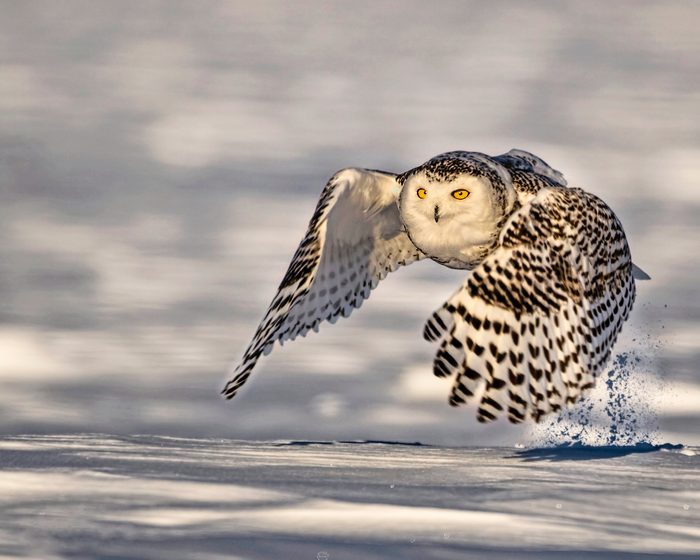
Snowy owls are common year-round in the Arctic on the open tundra. They fly south throughout Canada in winter. The best time to see a snowy owl in the lower 48 states is during an irruption. This can happen in winter when the owls unexpectedly travel farther south than normal, usually into the northern U.S. But they’ve been spotted as far south as Florida during a once-in-a-lifetime mega-irruption.
Surprisingly, these movements are actually not connected to a lack of food. Scientists have observed that irruptions occur in winters after lemmings and voles are plentiful in the snowy owls’ tundra breeding grounds, leading to a boom in their population.
Learn how to spot the owl in your backyard trees.
What Do Snowy Owls Look Like?
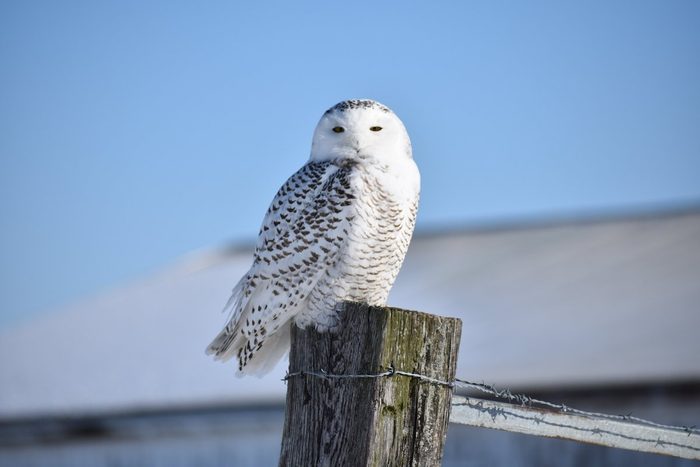
Featuring unique markings, which vary widely in color from brown to black and in shape from bars to spots, snowy owls are best known for their white plumage and feline-looking yellow eyes. For a beautiful collection of snowy owl photos and a personal narrative from photographer Paul Bannick, get a copy of Snowy Owl: A Visual Natural History.
Male and Female Snowy Owls
Males and female snowy owls look different. As with most raptors, females snowy owls are substantially bigger than males. At up to 6.5 pounds, females are the biggest owls by weight in North America. Females are also more heavily barred with black than the males, which get paler throughout their lives. An all-white snowy owl is pretty much always an older male (apologies to Harry Potter, but Hedwig was a male all along.)
Learn more fun facts about owls in pop culture.
Snowy Owl Size and Wingspan

These birds are large and can be spotted from very far away. While they are often surprisingly light, the snowy is the heaviest owl in North America. With a height of 2 1/2 feet, a wingspan of 5 feet and an average weight of 4 to 5 pounds, they’re one of the most powerful owls in the United States. Their extra body mass makes them a pound heavier than the great horned owl and twice the weight of a great gray owl.
Love owls? Check out these owl-themed t-shirts!
What Do Snowy Owls Eat?

Snowy owls are excellent hunters, and they make the most of the Arctic’s prodigious supplies of lemmings. Food options on the tundra are limited, making lemmings a critical part of a snowy owl’s diet. They pounce on them, take them on the wing, even snatch them from under the snow, finding them by sound alone if they need to. A single adult hunts all day in the Arctic daylight and may eat 300 pounds of lemmings per year, feeding its brood of “owlets” another 1,500 lemmings before they leave home. In winter, some switch to eating ptarmigan and waterfowl, such as grebes, loons, snow geese and great blue herons. John James Audubon reportedly saw one lying on its belly and catching fish from a rock.
Snowy Owl Call and Sounds

Snowy owls don’t have quite as thrilling a hoot as their nocturnal kin. Instead, they make simple, hoarse whoos or excitable squawks that don’t seem to fit their regal bearing.
Check out these unique owl gifts we can’t resist.
Snowy Owl Eggs
In summer, when lemming and vole populations surge in the north, female snowies can lay as many as 11 eggs in a season. Scott once saw five snowy owl eggs in the middle of a nest, surrounded by 78 dead lemmings and voles.
Learn about 8 different kinds of bird nests and how to spot them.
Baby Snowy Owl

Snowy owls split their parenting duties. While a snowy owl mom is busy with the nestlings, the dad brings food to keep everybody fed. If it’s been a particularly good year, he may leave a large stockpile of dead lemmings and other rodents around the nest for mom and the baby owlets.
Learn how to attract owls to nest in your backyard.
Snowy Owl Behavior
These owls are active during daytime. You might expect this of a bird that hails from the land of the midnight sun. If you’ve ever had the good fortune to see a snowy owl in the wild, you may have noticed that they seem calm. Some say it’s possible to get so close to a juvenile snowy that you can almost touch it. Considering they visit open, semi-populated areas such as farms, grasslands, seashores and the Great Lakes, they’re often close to people. While these birds are naive around humans, they’re known to be extremely territorial with other species. If you ever see one in person, remember: If the owl is looking directly at you, you’re too close.
Learn more about northern saw-whet owls.
Snowy Owls Don’t Get Cold

Remember, any snowy owl you see this winter is about as far south as it ever goes. Snowy owls live through dark, frigid winters, and sit through minus 40 degree nights without flinching. Regardless of how cold you might be, they really aren’t fazed by a 15-degree day in the Lower 48.
“Not a winter person by any stretch of the imagination, this magnificent bird (above) got me out of bed and outside on days when the mercury dipped below zero. This was one of those days when it was below zero with the wind whipping across the marsh. I was the only person out with my camera this particular morning. Just me and the owl what an awesome experience to share time with visitor from the north,” says Heather Tarzia.
Check out the 51 best winter bird photos.
Why Do Snowy Owls Visit Airports?

Some snowy owls hang out in fields near and around airports, as the birds are drawn to the open areas. They perch atop buildings and other structures so they can search for food. However, this dangerous behavior makes it easy for owls to get hit or killed by backwash from an airplane engine. Members of Project SNOWstorm often trap and remove the owls from airports across the country.
“Snowy owl irruptions made headlines across the northern states a few years ago. In Wisconsin, an airport had to develop a program to remove the majestic birds from dangerous areas. They utilized local falconers to trap and transport snowies to appropriate locations. After making sure the owls were healthy, they released them,” says Deb Potts of Weyauwega, Wisconsin.
Learn the story behind the rescue of a special bald eagle.
How Many Snowy Owls Are There?

Far fewer snowies exist than we previously thought. The total population was once guessed to be about 300,000 worldwide, but in reality it is actually closer to 30,000. For comparison, Partners in Flight—a network of organizations dedicated to bird conservation—puts the global population of black-capped chickadees at about 41 million. The reason for the change in estimate is because snowy owls travel thousands of miles between breeding seasons. Prior to modern tracking, individual birds were often counted more than once.
Project SNOWstorm helps track the movements of snowy owls using cutting edge technologies to log the precise latitude, longitude and altitude of tagged birds as frequently as every six seconds. Since 2013, Project SNOWstorm has become one of the world’s largest collaborative research projects. This project is funded entirely by the public and has tracked more than 90 snowy owls across the Dakotas, Great Lakes, New England, the mid-Atlantic and southern Canada. Its largely volunteer team consists of scientists, bird banders and wildlife veterinarians from across the country. Its latest efforts include tagging and tracking owls on the Great Plains and studying how the construction of wind turbines affects these birds. In addition, the group is researching the mortality and movements of juveniles, while also working with airport authorities to relocate owls that end up in harm’s way.

Whether dressing up indoor or outdoor spaces in fall or starring in seasonal desserts, pumpkins and gourds are autumn musts. To harvest them from your own garden next year, follow these simple tips on how to grow pumpkins. Then get a head start on your personal patch.
Pumpkins and gourds are members of the Cucurbitaceae family. When growing your own, pick from the wide assortment available in seed catalogs or online. Check out 10 seed catalogs every gardener needs.
Certain pumpkins are best for carving, while others make the sweetest pies. Read carefully to select pumpkin seeds that meet your garden goals.
Fruit sizes range from mini to massive; colors include classic orange as well as white, red, green, blue and yellow; and shapes vary from flat to round to tall.
Discover fascinating facts about pumpkins.
Growing Gourds
Gourds are also rewarding to grow. Two main types are available to gardeners: hard-shell and ornamental. Hard-shell gourds, such as birdhouse or long-dipper gourds, can be dried and kept indefinitely. The fruits are also edible when harvested immature. Ornamental gourds produce unique fruits in a wide mix of shapes, sizes and colors, but they aren’t edible and don’t dry well, so they’re best used as decor in autumn and then added to the compost pile.
Learn how to make a purple martin gourd house.
Tips to Grow Pumpkins Successfully
Do Pumpkins Need Full Sun?
Though they are pretty easy to grow, success with pumpkins and gourds begins with selecting the right spot. They need at least eight hours of sun each day as well as room for the vines to roam. If you lack growing space, plant bush or semi-bush options that don’t produce long vines.
Pumpkins and gourds are greedy plants, growing best when the soil is enhanced with several inches of compost or aged manure. It’s also a good idea to apply a slow-release vegetable fertilizer to the garden bed before planting.
Check out the top 10 vegetables that grow well in shade.
When to Plant Pumpkins
The heat-loving fruits shouldn’t be rushed into the spring garden since the seeds don’t germinate well in cold soil. Wait until your area’s last frost date has passed and the soil has warmed to 70 degrees. Then transplant or direct sow seeds into raised beds, in-ground gardens, straw bales, or hills, which are small mounds of soil piled up to improve drainage and raise soil temperature. Sow seeds a half inch to an inch deep. Spacing depends on the selected variety. Refer to your seed packets for specific spacing information.
Learn how to recycle pumpkins for birds and wildlife.
Pumpkin Fertilizer
Once in the garden, pumpkins and gourds are easygoing. Keep an eye on soil moisture, watering deeply when the soil is dry. Water the soil, not the plant, as splashing water can increase the risk of soil-borne disease. Promote healthy growth by fertilizing every two to three weeks with either a liquid kelp or fish fertilizer.
Stop Pumpkin Bugs
Also watch out for pests like squash bugs and squash vine borers. If borers are an annual issue in your garden, wrap a 6-inch piece of aluminum foil around the bottom of each stem. This helps reduce the number of female vine borers laying eggs on the plant stems.
Find out how to get rid of slugs and snails in the garden.
How to Grow Big Pumpkins

When several pumpkins have formed on each vine, pinch back the growing tip. This directs the plant’s energy into maturing existing fruits, not producing more flowers. The late flowers won’t have time to mature into good-sized pumpkins. Pinching also leads to bigger pumpkins. Pinching hard-shell gourds is helpful too, but there’s no need to prune back the plants of ornamental gourds.
Backyard project: Make a DIY pumpkin bird feeder.
How to Pollinate Pumpkins
During summer, another task to consider is pollination. Gourds and pumpkins produce separate male and female flowers. Pollen needs to be transferred from a male flower to a female flower for fruits to form. Bees typically take care of this, but you can lend Mother Nature a hand by using a small clean paintbrush to move pollen to the flowers. Hand pollinate on a dry, sunny day.
Create no-carve patterned pumpkins for Halloween.
How Long Do Pumpkins Take to Grow?
First-time growers may have a hard time knowing when it’s time to harvest their pumpkins and gourds. The biggest clue is color. With a sharp pair of pruners, clip fruits from vines when they’ve turned their mature color. Leave a 2-to-4-inch-long stem attached to each fruit. Be sure to harvest before a hard frost, which can damage the fruits. The number of days to maturity for pumpkins and gourds will vary depending on the variety, but expect a range of 90 to 120 days.
Check out the top 10 fall vegetables to extend the harvest.
Curing Pumpkins
Let pumpkins and gourds cure in the sun for five to seven days if the weather allows. Curing keeps pumpkins from decaying too quickly. If cold and frost are threats, bring the fruits indoors to a warm spot with decent air circulation to cure.
Psst—here’s more tips on how to preserve a pumpkin the right way.
The Best New Pumpkin Varieties to Grow

Toad
This compact plant, perfect for small gardens or containers, produces five to six small bright orange pumpkins covered with large bumps.

Blue Prince
These large flattened blue-gray pumpkins are both decorative and delicious. Use the roasted creamy flesh in favorite fall recipes.

Silver Edged
The vine yields a heavy crop of green and silvery white striped fruits. The 5-to-8-pound pumpkins are packed with large seeds for roasting.

Shiver
Compact pumpkins with ghostly white skin and a round shape grow on a bush-type plant ideal for small spaces.

Blanco
The smooth white pumpkins are deer resistant and just the right size for small jack-o’-lanterns.

Lemonade
Golden yellow skin adds a sunny new hue to your seasonal autumn decor.
Do Birds Eat Wheat?
Question: “A bag of bird seed that I bought (and later threw away) had wheat in it. None of my birds ate it. Even a flock of starlings over 100 strong left it on the ground. Is there something about wheat that birds don’t like?” asks Marilyn Michalls of Basehor, Kansas.
Kenn and Kimberly: Some larger birds, such as quail and doves, readily eat wheat if nothing else is available. Blackbirds sometimes eat wheat as well. But generally it’s a last resort for most backyard birds. Wheat is often used as filler in some inexpensive seed mixes, but birds frequently just leave it on the ground where it goes to waste, as you’ve observed. We recommend reading the list of ingredients carefully before you purchase a mix. If you’re on a tight budget, it’s better to buy smaller quantities of high-quality seed and put out just a little at a time.
Offer Quality Bird Seed
Question: “New neighbors moved in nearby and put up four feeders, but birds no longer visit my feeders. Will they ever come back?” asks Jill Sosnowski of Roscoe, Illinois.
Kenn and Kimberly: Birds sometimes seem like fickle guests, jumping ship as soon as they get a better offer. About all you can do is provide high-quality bird food, keep your feeders clean and hope the birds rediscover your hospitality. Focus on seeds such as black oil sunflower and Nyjer (thistle), and try suet cakes hung on tree trunks. It helps if your feeders are fairly close to shrubs or trees so birds can quickly take cover if they feel threatened. And if you provide water in a bird bath that’s kept clean, all that might be enough to lure your birds back.
Each month, Birds & Blooms readers send in questions to birding experts, Kenn and Kimberly Kaufman, who are the duo behind the Kaufman Field Guide series. Got a bird question for Kenn and Kimberly? Submit your questions here! They may appear here or in a future issue of the magazine.
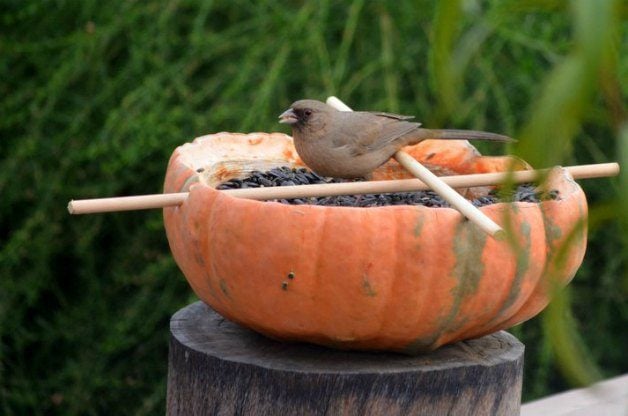
Halloween has arrived and pumpkins are everywhere—some carved into creative faces, or others left uncarved where their bright colors add great fall color. But, what do you do with your pumpkin when Halloween is over? Do you throw them in the compost pile or trash bin? What if you could get more use out of your pumpkin and benefit wildlife at the same time? Creating a pumpkin bird feeder is a fun and easy backyard project and you most likely already have all you need to get started—a pumpkin! We have instructions for making a feeder with a real or an artificial pumpkin.
Here’s how to make a super cute, no-carve owl pumpkin.
DIY Pumpkin Bird Feeder Instructions
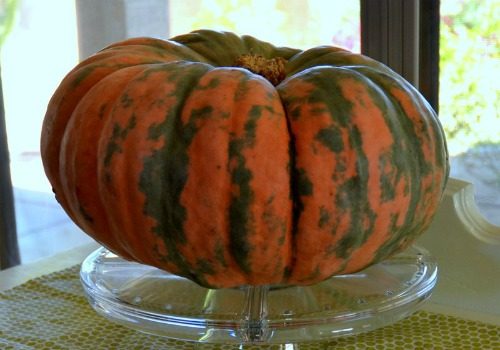
I used the heirloom pumpkin that had been decorating my home for the fall holidays to make my DIY pumpkin bird feeder.
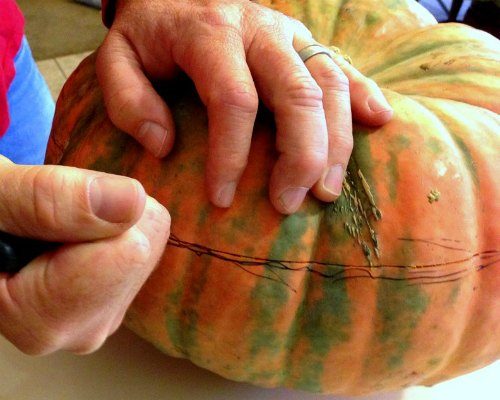
1. Cut your pumpkin in half. If your pumpkin still has seeds inside, scoop them out and roast them or save a few to plant pumpkins in your garden next year.
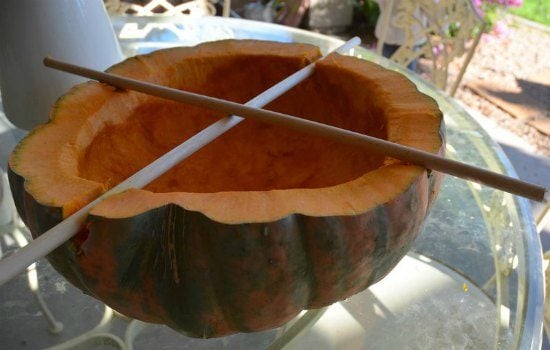
2. Carve four small trenches in which to rest perches for your feathered visitors. You can put in wooden dowels or small branches as perches.
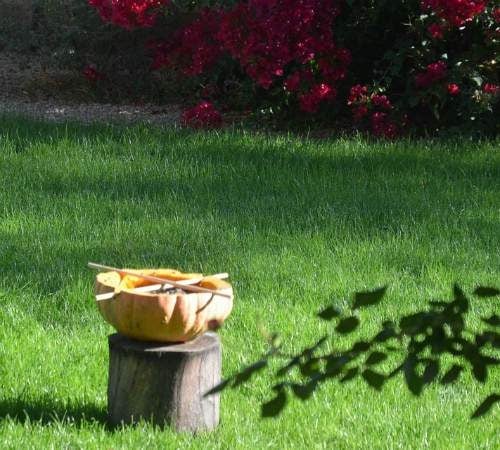
3. Fill the pumpkin with bird seed and set it outside. I placed our pumpkin on an old tree stump so that I could more easily see it from the house. You could also use sturdy twine to hang it up—simply knot two lengths of twine together in the middle and set the pumpkin on the knotted section. Bring up the ends and hang from your favorite hook or bird feeder pole.
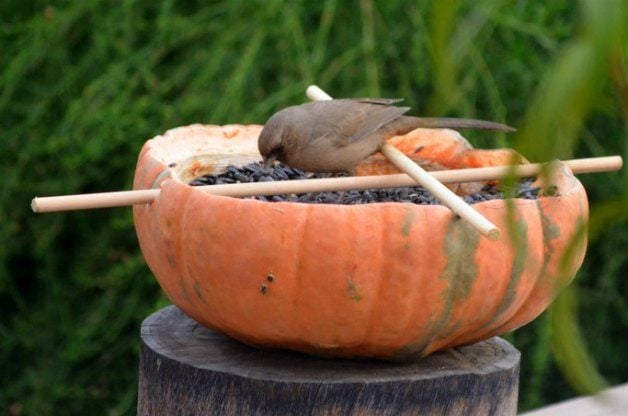
Needless to say, it didn’t take long to attract visitors. A pair of Abert’s towhees, birds that are mostly found in Arizona, were the first visitors.
These pumpkin bird feeders won’t last forever, but I like the idea of getting more use out of my pumpkins before I throw them into my compost pile.
Check out 5 fascinating facts about pumpkins.
Artificial Pumpkin Bird Feeder
You can also make a pumpkin bird feeder with an artificial pumpkin, so it will last longer. I used decorative scrapbooking brads for the embellishments, but you could also explore the wide variety of pushpins available. Just be sure that whatever you use is firmly attached to the pumpkin, since some birds love to carry off shiny things for their collections.
Psst—here’s another fun fall decorating idea: fill a pumpkin with flowers!
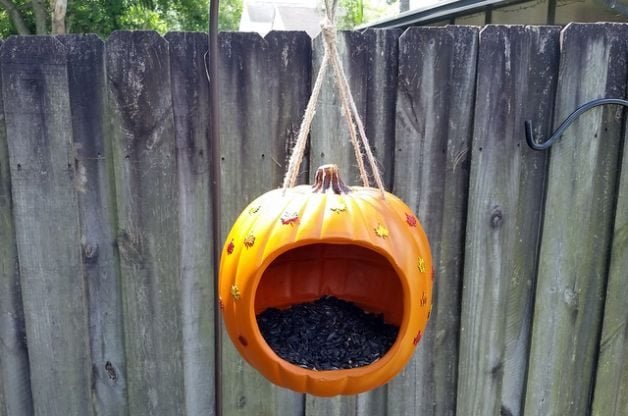
Materials
- Diorama Craft Pumpkin (if you’re unable to find this kind, use an artificial pumpkin and cut the hole yourself)
- Leaf-shaped brads (find them in the scrapbooking section)
- Heavy twine, about 4 feet
- Drill
- Scissors
- Pushpin
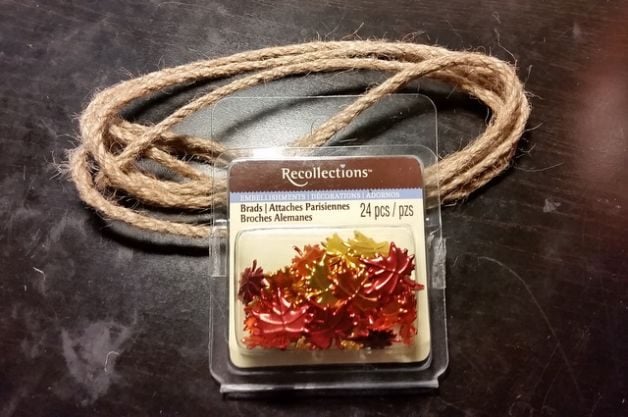
Instructions
- Wipe down the pumpkin with a damp cloth to remove any residue from manufacture.
- Use a drill to make several holes in the base of the pumpkin to allow for drainage.
- On the top of the pumpkin, drill four holes evenly spaced holes. Wipe down the pumpkin again to remove any pieces or residue from drilling.
- Cut two pieces of twine, about 2 feet each. Thread one piece through two of the holes, repeat with the other. Knot all the twine ends together to create the hanger.
- To add the leaf embellishments, first poke a tiny hole in the pumpkin with a pushpin. Then push the points of the brad in firmly. The points may push all the way through to the other side; if so, bend them flush so they don’t pose a threat to birds.
- Fill with your favorite type of bird seed, hang on a feeder pole, and enjoy!
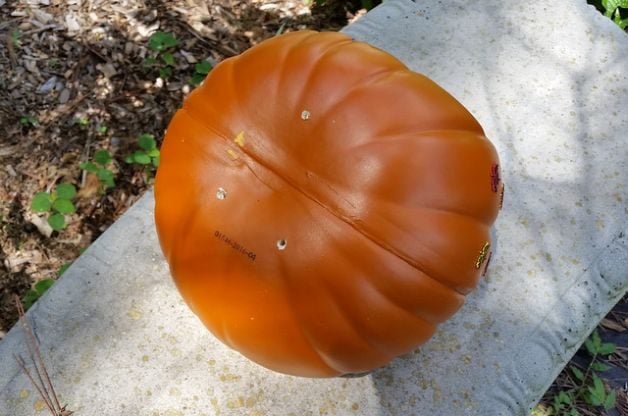
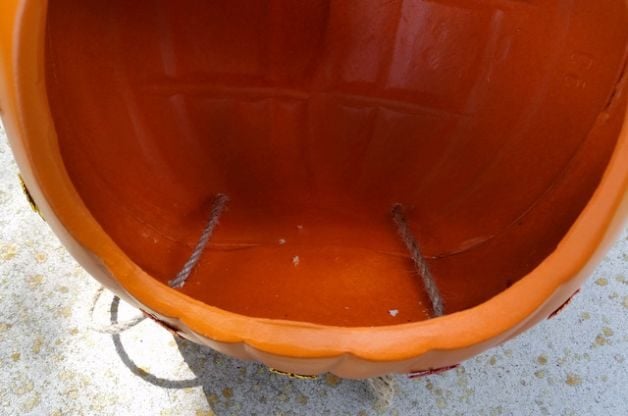
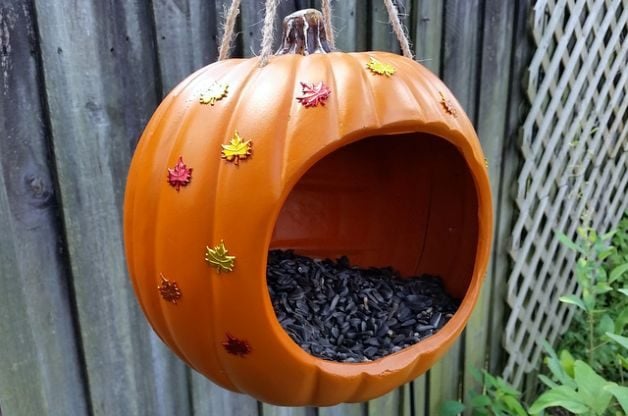
Next, learn how to make a tipsy pumpkin planter.
Passenger Pigeon

1. Passenger pigeons have been extinct for more than 100 years. At one time, huge flocks of these birds darkened the sky as they moved around eastern North America.
Dusky Seaside Sparrow
2. Only six dusky seaside sparrows, all male, were left in 1979. Pollution, pesticides and loss of marsh habitat caused the extinction of the bird species. All about sparrows: What birders should know.
Great Auk

3. Great auks were hunted for their meat, feathers, and eggs, leading to their extinction in the 1800s. Today, stuffed specimens of this extinct bird are rare; only about 80 exist in museum collections around the world.
Heath Hen
4. Heath hens vanished in 1932. A subspecies of today’s greater prairie-chicken, they were last seen at a reserve on Martha’s Vineyard.
Carolina Parakeet
5. Only one parrot species was native to the U.S.: the Carolina parakeet. Once abundant in North America, farmers killed off large numbers of these birds, contributing to their official extinction in 1939.
Great Toothed Diver
6. The great toothed diver (Hesperornis regalis) lived more than 83 million years ago. Flightless, it used its hind legs and lobed toes to swim, similar to grebes. It was about 5 feet long! Check out 20 types of ducks to look for in spring.
Ivory-Billed Woodpecker

7. The ivory-billed woodpecker was once the third-largest woodpecker in the world. It was believed to have gone extinct at least 50 years ago, but brief sightings were reported from Arkansas’ Big Woods in 2004 and 2005. Despite extensive efforts to locate the bird, the species was recently officially declared extinct by the U.S. Fish & Wildlife Service. Discover 11 types of woodpeckers birders should know.

